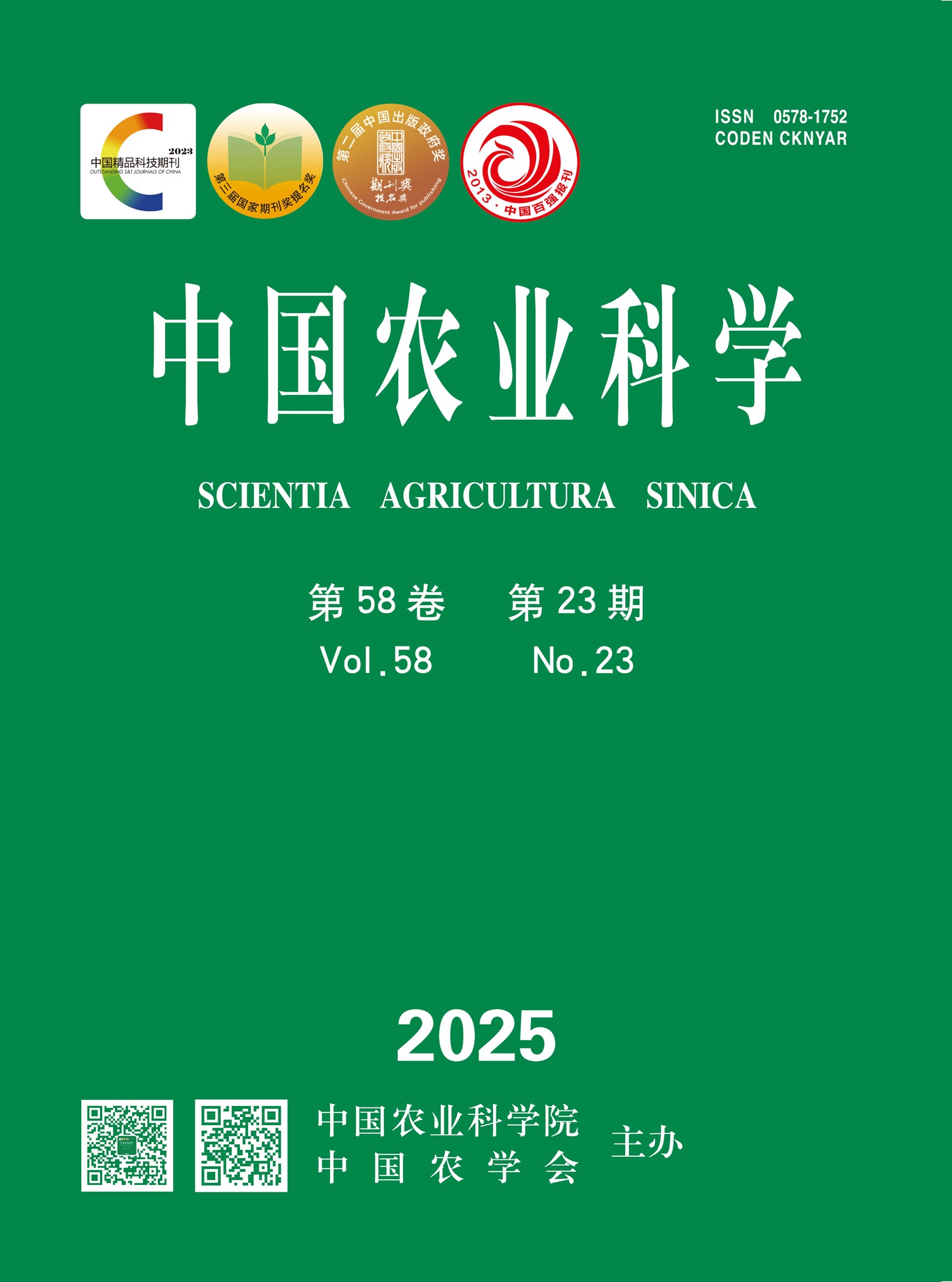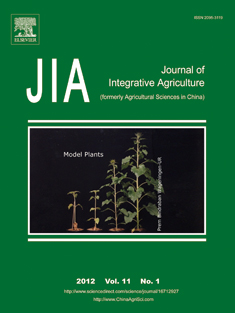

Semimonthly
Started in 1960
ISSN 0578-1752
CN 11-1328/S
Started in 1960
ISSN 0578-1752
CN 11-1328/S
Journal Online



Research HighlightsMore...
01 December 2025, Volume 58 Issue 23
Please wait a minute...
| More... |
| Aroma Quality Analysis of Guangdongxiangshui Lemon Based on Molecular Sensory Technology |
| ZHANG SiNing, ZHANG XingRui, WU DongXuan, KANG JingBo, CHEN XiaoLin, GENG LiJun, YIN GuangMin, CHEN JiaJing, GAO JunYan, CAI ZhongHu, LIU Yuan, XU Juan |
| Scientia Agricultura Sinica. 2025 Vol. 58 (1): 141-155 |
| doi: 10.3864/j.issn.0578-1752.2025.01.011 |
|
|
| CRISPR-Cas12a Gene Editing Technology and Its Application in Agricultural Production |
| LUO Gang, CHENG YiYi, YANG Wen, XIAO YiMeng, YANG ChengXi |
| Scientia Agricultura Sinica. 2025 Vol. 58 (7): 1434-1450 |
| doi: 10.3864/j.issn.0578-1752.2025.07.014 |
|
|
| Research Progress on Seed Shattering of Rice |
| LÜ ShuWei, TANG Xuan, LI Chen |
| Scientia Agricultura Sinica. 2025 Vol. 58 (1): 1-9 |
| doi: 10.3864/j.issn.0578-1752.2025.01.001 |
|
|
| Cloning and Heat Tolerance Function of Wheat TaGRAS34-5A Gene |
| DIAO DengChao, LI YunLi, MENG XiangYu, JI SongHan, SUN YuChen, MA XueHong, LI Jie, FENG YongJia, LI ChunLian, WU JianHui, ZENG QingDong, HAN DeJun, $\boxed{\hbox{WANG ChangFa}}$, ZHENG WeiJun |
| Scientia Agricultura Sinica. 2025 Vol. 58 (4): 617-634 |
| doi: 10.3864/j.issn.0578-1752.2025.04.001 |
|
|
| Scientia Agricultura Sinica. 2025 Vol. 58 (20): 0- |
|
|
| Effects on Pollen Release Related Traits of the Differential Genotypes Indica by High-Temperature Stress at Anthesis |
| DU SiQi, WEN YuLun, NING LiXing, YIN XiaoYu, WANG ShuFen, SONG HaiYan, WANG ZhaoHai, LI WeiXing, LIAO JiangLin |
| Scientia Agricultura Sinica. 2025 Vol. 58 (10): 1867-1877 |
| doi: 10.3864/j.issn.0578-1752.2025.10.001 |
|
|
| The Function of OsDREB1J in Regulating Rice Grain Size |
| WEI Ping, PAN JuZhong, ZHU DePing, SHAO ShengXue, CHEN ShanShan, WEI YaQian, GAO WeiWei |
| Scientia Agricultura Sinica. 2025 Vol. 58 (8): 1463-1478 |
| doi: 10.3864/j.issn.0578-1752.2025.08.001 |
|
|
| Genome-Wide Identification of Soybean LOX Gene Family and the Effect of GmLOX15A1 Gene Allele on 100-Seed Weight |
| WANG Wei, WU ChuanLei, HU XiaoYu, LI JiaJia, BAI PengYu, WANG GuoJi, MIAO Long, WANG XiaoBo |
| Scientia Agricultura Sinica. 2025 Vol. 58 (1): 10-29 |
| doi: 10.3864/j.issn.0578-1752.2025.01.002 |
|
|
| The Impact of Diversified Crops and Wheat-Maize Rotations on Soil Quality in the North China Plain |
| ZHANG SiJia, YANG Jie, ZHAO Shuai, LI LiWei, WANG GuiYan |
| Scientia Agricultura Sinica. 2025 Vol. 58 (2): 238-251 |
| doi: 10.3864/j.issn.0578-1752.2025.02.003 |
|
|
| Characterization and Correlation Analysis of Soil Dissolved Organic Matter and Microbial Communities Under Long-Term Application of Fresh and Composted Manure |
| YUAN HuiLin, LI YaYing, GU WenJie, XU PeiZhi, LU YuSheng, SUN LiLi, ZHOU ChangMin, LI WanLing, QIU RongLiang |
| Scientia Agricultura Sinica. 2025 Vol. 58 (2): 307-325 |
| doi: 10.3864/j.issn.0578-1752.2025.02.008 |
|
|
| The Dilemma and Way Out of Patent Regulation for Gene-Edited Crops |
| XU YiHeng |
| Scientia Agricultura Sinica. 2025 Vol. 58 (5): 831-839 |
| doi: 10.3864/j.issn.0578-1752.2025.05.001 |
|
|
| Effects of LED Supplementary Lighting on Production and Leaf Physiological Properties of Substrate-Cultivated Strawberry in Chinese Solar Greenhouse |
| ZHANG Han, ZHANG YuQi, LI JingLai, XU Hong, LI WeiHuan, LI Tao |
| Scientia Agricultura Sinica. 2025 Vol. 58 (5): 975-990 |
| doi: 10.3864/j.issn.0578-1752.2025.05.012 |
|
|
| Influence of Expressing OsNRAMP5 Under the Driving of the OsLCT1 Promoter on Cadmium Migration to Rice Seeds |
| XIONG JiaNi, LI ZongYue, HU HengLiang, GU TianYu, GAO Yan, PENG JiaShi |
| Scientia Agricultura Sinica. 2025 Vol. 58 (7): 1259-1268 |
| doi: 10.3864/j.issn.0578-1752.2025.07.001 |
|
|
| Screening and Identification of Drought-Tolerant Sweet Potato Germplasm Resources |
| CHEN YongXian, CHEN RuiJiang, DU YiZhi, ZHU JunJie, CHEN WanXia, ZHAO ZiHan, WANG JiChun, DU Kang, ZHANG Kai |
| Scientia Agricultura Sinica. 2025 Vol. 58 (2): 214-237 |
| doi: 10.3864/j.issn.0578-1752.2025.02.002 |
|
|
| Cloning of the Promoters and Analysis of Expression Patterns of Maturity Genes E1 and E2 in Soybean |
| LIU LuPing, HU XueJie, QI Jin, CHEN Qiang, LIU Zhi, ZHAO TianTian, SHI XiaoLei, LIU BingQiang, MENG QingMin, ZHANG MengChen, HAN TianFu, YANG ChunYan |
| Scientia Agricultura Sinica. 2025 Vol. 58 (5): 840-850 |
| doi: 10.3864/j.issn.0578-1752.2025.05.002 |
|
|
| Physiological Characteristics in Response to Salt Stress and Allelic Variation and Expression of Salt-Responsive Genes in Seedling Stage of Nangeng Rice Varieties with Salt-Tolerance Ability |
| DENG LiCheng, LI Cheng, HE Lei, AN HongQiang, WANG CaiLin, ZHANG YaDong, ZHAO ChangJiang, LU Kai |
| Scientia Agricultura Sinica. 2025 Vol. 58 (12): 2275-2290 |
| doi: 10.3864/j.issn.0578-1752.2025.12.001 |
|
|
| Research Progress and Prospects on Crop Pan-Genomics |
| WANG Hui, DING BaoPeng, LI YuXian, REN QuanRu, ZHOU Hai, ZHAO JunLiang, HU HaiFei |
| Scientia Agricultura Sinica. 2025 Vol. 58 (11): 2045-2061 |
| doi: 10.3864/j.issn.0578-1752.2025.11.001 |
|
|
| Research Progress on Mechanisms Interpretation and Prediction Methods for Heterosis of Livestock |
| SUN YanYan, NI AiXin, YANG HanHan, YUAN JingWei, CHEN JiLan |
| Scientia Agricultura Sinica. 2025 Vol. 58 (5): 1017-1031 |
| doi: 10.3864/j.issn.0578-1752.2025.05.015 |
|
|
| Heterosis Groups Research in Maize Inbred Lines Based on Machine Learning |
| CAO ShiLiang, ZHANG JianGuo, YU Tao, YANG GengBin, LI WenYue, MA XueNa, SUN YanJie, HAN WeiBo, TANG Gui, SHAN DaPeng |
| Scientia Agricultura Sinica. 2025 Vol. 58 (2): 203-213 |
| doi: 10.3864/j.issn.0578-1752.2025.02.001 |
|
|
| Genome-Wide Association Study of Heat Tolerance at Seedling Stage in A Wheat Natural Population |
| LI YunLi, DIAO DengChao, LIU YaRui, SUN YuChen, MENG XiangYu, WU ChenFang, WANG Yu, WU JianHui, LI ChunLian, ZENG QingDong, HAN DeJun, ZHENG WeiJun |
| Scientia Agricultura Sinica. 2025 Vol. 58 (9): 1663-1683 |
| doi: 10.3864/j.issn.0578-1752.2025.09.001 |
|
|
| More... |
| Effects of Mating Flight on sRNAs Expression in Sexual Matured Virgin Queens (Apis cerana cerana) |
| WU Xiao-Bo, WANG Zi-Long, SHI Yuan-Yuan, ZHANG Fei, ZENG Zhi-Jiang |
| Scientia Agricultura Sinica. 2013 Vol. 46 (17): 3721-3728 |
| doi: 10.3864/j.issn.0578-1752.2013.17.022 |
|
|
| Discussion on the Theory and Methods for Determining the Target Yield in Rice Production |
| ZOU Ying-bin, XIA Bing, JIANG Peng, XIE Xiao-bing, HUANG Min |
| Scientia Agricultura Sinica. 2015 Vol. 48 (20): 4021-4032 |
| doi: 10.3864/j.issn.0578-1752.2015.20.004 |
|
|
| null |
| null |
| Scientia Agricultura Sinica. 1978 Vol. 11 (02): 16-20 |
| doi: 10.3864/j.issn.0578-1752.1978-11-02-16-20 |
|
|
| Bioinformatics and Expression Analysis of the WRKY Gene Family in Apple |
| GU Yan-bing, JI Zhi-rui, CHI Fu-mei, QIAO Zhuang, XU Cheng-nan, ZHANG Jun-xiang, DONG Qing-long, ZHOU Zong-shan |
| Scientia Agricultura Sinica. 2015 Vol. 48 (16): 3221-3238 |
| doi: 10.3864/j.issn.0578-1752.2015.16.012 |
|
|
| Expression and Function Analysis of the Transcription Factor GmMYB111 in Soybean |
| XU Ling, WEI Pei-pei, ZHANG Da-yong, XU Zhao-long, HE Xiao-lan, HUANG Yi-hong, MA Hong-xiang, SHAO Hong-bo |
| Scientia Agricultura Sinica. 2015 Vol. 48 (15): 3079-3089 |
| doi: 10.3864/j.issn.0578-1752.2015.15.019 |
|
|
| Effects of Water Stress at Different Growth Stages on the Development and Yields of Winter Wheat in Arid Region |
| YAO Ning, SONG Li-bing, LIU Jian, FENG Hao, WU Shu-fang, HE Jian-qiang |
| Scientia Agricultura Sinica. 2015 Vol. 48 (12): 2379-2389 |
| doi: 10.3864/j.issn.0578-1752.2015.12.011 |
|
|
| Response of Wheat Root Characteristics and Canopy Photosynthesis to Different Irrigation Methods in Lime Concretion Black Soil |
| ZHANG Xiang-qian, CAO Cheng-fu, QIAO Yu-qiang, LI Wei, CHEN Huan |
| Scientia Agricultura Sinica. 2015 Vol. 48 (8): 1506-1517 |
| doi: 10.3864/j.issn.0578-1752.2015.08.05 |
|
|
| Difference Analysis of Post-Anthesis Matter Production and Senescence Characteristics Among Different Nitrogen Efficiency Populations in Wheat Following Rice |
| DING Jin-feng, CHENG Ya-mei, HUANG Zheng-jin, LI Chun-yan, GUO Wen-shan, ZHU Xin-kai |
| Scientia Agricultura Sinica. 2015 Vol. 48 (6): 1063-1073 |
| doi: 10.3864/j.issn.0578-1752.2015.06.03 |
|
|
| Differences in Nitrogen Efficiency and Nitrogen Metabolism of Wheat Varieties Under Different Nitrogen Levels |
| WANG Xiao-chun, WANG Xiao-hang, XIONG Shu-ping, MA Xin-ming, DING Shi-jie, WU Ke-yuan, GUO Jian-biao |
| Scientia Agricultura Sinica. 2015 Vol. 48 (13): 2569-2579 |
| doi: 10.3864/j.issn.0578-1752.2015.13.009 |
|
|
| Agronomic Traits Variation Analysis of Huanghuai Dryland Winter Wheat under Temperature Change Background in China ——Taking Linfen, Shanxi as an Example |
| LIU Xin-yue, PEI Lei, WEI Yun-zong, ZHANG Zheng-bin, GAO Hui-ming, XU Ping |
| Scientia Agricultura Sinica. 2015 Vol. 48 (10): 1942-1954 |
| doi: 10.3864/j.issn.0578-1752.2015.10.007 |
|
|
| Study on Producing Area Classification of Newhall Navel Orange Based on the Near Infrared Spectroscopy |
| LIAO Qiu-hong, HE Shao-lan, XIE Rang-jin, QIAN Chun, HU De-yu, Lü Qiang1,YI Shi-lai, ZHENG Yong-qiang, DENG Lie |
| Scientia Agricultura Sinica. 2015 Vol. 48 (20): 4111-4119 |
| doi: 10.3864/j.issn.0578-1752.2015.20.012 |
|
|
| Research Advances of Applying Virus-Induced Gene Silencing in Vegetables |
| LI Jie,LUO JiangHong,YANG Ping |
| Scientia Agricultura Sinica. 2021 Vol. 54 (10): 2154-2166 |
| doi: 10.3864/j.issn.0578-1752.2021.10.011 |
|
|
| Research Progress of Soil Microbial Mechanisms in Mediating Plant Salt Resistance |
| KONG YaLi,ZHU ChunQuan,CAO XiaoChuang,ZHU LianFeng,JIN QianYu,HONG XiaoZhi,ZHANG JunHua |
| Scientia Agricultura Sinica. 2021 Vol. 54 (10): 2073-2083 |
| doi: 10.3864/j.issn.0578-1752.2021.10.004 |
|
|
| Identification and Expression Analysis of 1-Aminocyclopropane- 1-Carboxylate Oxidase Gene from Quinclorac-Resistant Barnyardgrass (Echinochloa crus-galli) |
| DONG Ming-chao, YANG Xia, ZHANG Zi-chang, LI Yong-feng, GUAN Rong-zhan |
| Scientia Agricultura Sinica. 2015 Vol. 48 (20): 4077-4085 |
| doi: 10.3864/j.issn.0578-1752.2015.20.009 |
|
|
| Molecular Cloning and Function of the Yellow Gene from Nilaparvata lugens |
| WANG Bo, YAO Yun, XU Ze-wei, LIN Xin-da |
| Scientia Agricultura Sinica. 2015 Vol. 48 (15): 2976-2984 |
| doi: 10.3864/j.issn.0578-1752.2015.15.007 |
|
|
| Advances in Research of Transcriptional Regulatory Network in Response to Cold Stress in Plants |
| LIU Hui, LI De-jun, DENG Zhi |
| Scientia Agricultura Sinica. 2014 Vol. 47 (18): 3523-3533 |
| doi: 10.3864/j.issn.0578-1752.2014.18.001 |
|
|
| Research on Digitizing Morphological Structure and Growth Process of Grape Tree |
| WEN Wei-liang, WANG Yong-jian, LI Chao, WANG Chuan-yu, GUO Xin-yu |
| Scientia Agricultura Sinica. 2015 Vol. 48 (11): 2143-2151 |
| doi: 10.3864/j.issn.0578-1752.2015.11.006 |
|
|
| Review on Research in Plant Nutrition and Fertilizers |
| BAI You-lu |
| Scientia Agricultura Sinica. 2015 Vol. 48 (17): 3477-3492 |
| doi: 10.3864/j.issn.0578-1752.2015.17.014 |
|
|
| Physiological Mechanisms of Abiotic Stress Priming Induced the Crops Stress Tolerance: A Review |
| WANG Xiao, CAI Jian, ZHOU Qin, DAI TingBo, JIANG Dong |
| Scientia Agricultura Sinica. 2021 Vol. 54 (11): 2287-2301 |
| doi: 10.3864/j.issn.0578-1752.2021.11.004 |
|
|
| Characteristics and Succession of Rhizosphere Soil Microbial Communities in Continuous Cropping Watermelon |
| GUO HanYue, WANG DongSheng, RUAN Yang, QIAO YiZhu, ZHANG YunTao, LI Ling, HUANG QiWei, GUO ShiWei, LING Ning, SHEN QiRong |
| Scientia Agricultura Sinica. 2023 Vol. 56 (21): 4245-4258 |
| doi: 10.3864/j.issn.0578-1752.2023.21.009 |
|
|
| More... |
| The Complete Genome Sequence of the Gram-Positive Bacterium Bacillus subtils Bs-916 |
| WANG Xiao-Yu, LUO Chu-Ping, CHEN Zhi-Yi, LIU Yong-Feng, LIU You-Zhou, NIE Ya-Feng, YU Jun-Jie, YIN Xiao-Le |
| Scientia Agricultura Sinica. 2011 Vol. 44 (23): 4807-4814 |
| Cited by: Baidu(4225) |
| Study on Precise and Quantitative N Application in Rice |
| ,,,,,,,, |
| Scientia Agricultura Sinica. 2005 Vol. 38 (12): 2457-2467 |
| Cited by: Baidu(220) |
| Impact of Land Fragmentation on Small Rice Farmers’ Technical Efficiency in Southeast China |
| ,, |
| Scientia Agricultura Sinica. 2006 Vol. 39 (12): 2467-2473 |
| Cited by: Baidu(204) |
| Changes of Aroma Constituents in Apricot During Fruit Development |
| ,,,,, |
| Scientia Agricultura Sinica. 2005 Vol. 38 (06): 1244-1249 |
| Cited by: Baidu(166) |
| More... |
Journal
Founded to Commemorate
Visited
-
Total visitors:
Visitors of today:
Now online:










 www.caas.net.cn
www.caas.net.cn

